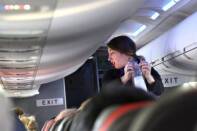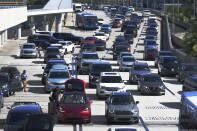With our free press under threat and federal funding for public media gone, your support matters more than ever. Help keep the LAist newsroom strong, become a monthly member or increase your support today.
Boyle Heights gets its first $35,000 bus shelter in city’s push for shade equity

This story was originally published by Boyle Heights Beat on May 30, 2025.
Los Angeles’ long-awaited bus shelters are starting to appear in Boyle Heights, with the neighborhood’s first structure installed near the corner of Soto and 1st streets.
The modern pale green shelter features perforated metal walls, an extended canopy shading three seats, static advertising space and a scannable QR code with real-time arrival estimates.
“This is really nice. We have shade now and it’s going to be nice in the summer,” said Christina Lopez, who rides the 605 Metro bus almost daily. “There wasn’t any cover before and it was a little ugly; the paint was peeling off.”
The shelter is part of a five-year effort by the Bureau of Street Services (StreetsLA) under the Department of Public Works. The Sidewalk and Transit Amenities Program (STAP) aims to install 3,000 upgraded transit shelters across the city, with a goal to provide shade for 75% of bus riders in each Council District.
The rollout, which has faced delays, prioritizes neighborhood equity and economic need, and takes into account transit ridership, the heat index, and key destinations. Shelters have already been installed in communities like Echo Park and Koreatown.

In Boyle Heights, where summer temperatures regularly soar, new shelters would offer critical relief for transit riders facing extreme heat. The eastbound bus stop on Whittier Boulevard and Soto Street, which is slated for a shelter upgrade, is considered one of the hottest in Los Angeles by Climate Resolve.
Citywide, only 26% of the nearly 12,000 Metro stops in Los Angeles have shade, according to a 2023 study from UCLA’s Lewis Center for Regional Policy Studies.
Each upgraded shelter costs around $35,000, excluding sidewalk construction and electrical, according to a spokesperson of the Department of Public Works. As of March 2024, the STAP program had secured $103 million in funding but required an estimated total investment of $300 million. It remains unclear whether some shelters will eventually include digital display panels intended to generate revenue for the project.
Additional Boyle Heights shelters are planned for high-traffic corridors such as Cesar Chavez Avenue and Whittier Boulevard.
Locations expected to see upgrades in the coming year include:
- Cesar E. Chavez Avenue and Soto Street
- Wabash Avenue and Soto Street
- Cesar E. Chavez Avenue and Boyle Avenue
As part of the program, sidewalk areas in need of repair surrounding new STAP shelters will be refurbished or reconstructed to ensure accessibility for riders and nearby pedestrians alike. Shelters will also feature push-to-talk buttons with multilingual capabilities and emergency call features to keep transit riders safe at stops.
According to STAP’s website, additional amenities such as Wi-Fi and phone charging stations will be considered in future shelters.










